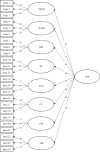Virtuous Organizational Practices: A New Construct and a New Inventory
- PMID: 34721186
- PMCID: PMC8548739
- DOI: 10.3389/fpsyg.2021.724956
Virtuous Organizational Practices: A New Construct and a New Inventory
Abstract
Research on the identification of organizational practices that promote individual and organizational performance is now very extensive. However, several studies have revealed the dark side of these practices on employees' psychological health. Consequently, researchers have called on the scientific community to focus on the well-being of workers and to identify the organizational practices that promote it. Thus, the aim of the present research was to fill this gap by introducing a new conceptualization of organizational practices supporting the psychological health of employees and proposing a new improved measure to assess them. Drawing on the American Psychological Association's model of Psychologically healthy workplace, we first conceptualized the innovative multidimensional construct of virtuous organizational practices. We then conducted four studies (N = 1,407) to develop and validate the Virtuous Organizational Practices inventory. Results of exploratory statistical analyses provide strong evidence of the second-order factor structure of the inventory in different French samples and of the convergent, predictive and incremental validity of this tool. Implications for researchers, organizations and practitioners and avenues for future research are discussed.
Keywords: VOPi; organizational virtuousness; psychological health; scale; virtuous organizational practices; virtuous organizational practices inventory; well-being.
Copyright © 2021 Aubouin-Bonnaventure, Fouquereau, Coillot, Lahiani and Chevalier.
Conflict of interest statement
FL headed AD Conseil. The remaining authors declare that the research was conducted in the absence of any business or financial relationship that could be construed as a potential conflict of interest.
Figures
References
-
- Adams J. S. (1965). “Inequity in social exchange,” in Advances in experimental social psychology, ed. Berkowitz L. (New York, NY: Academic press; ), 267–299.
-
- Akaike H. (1987). Factor analysis and AIC. Psychometrika 52 317–332. 10.1007/BF02294359 - DOI
-
- Andersén J., Andersén A. (2019). Are high-performance work systems (HPWS) appreciated by everyone? The role of management position and gender on the relationship between HPWS and affective commitment. Empl. Relat. 41 1046–1064. 10.1108/ER-03-2018-0080 - DOI
-
- Armstrong-Stassen M., Stassen K. (2013). Professional development, target-specific satisfaction, and older nurse retention. Career Dev. Int. 18 673–693. 10.1108/CDI-08-2013-0102 - DOI
-
- Armstrong-Stassen M., Ursel N. D. (2009). Perceived organizational support, career satisfaction, and the retention of older workers. J. Occup. Organ. Psychol. 82 201–220. 10.1348/096317908X288838 - DOI
LinkOut - more resources
Full Text Sources
Miscellaneous


